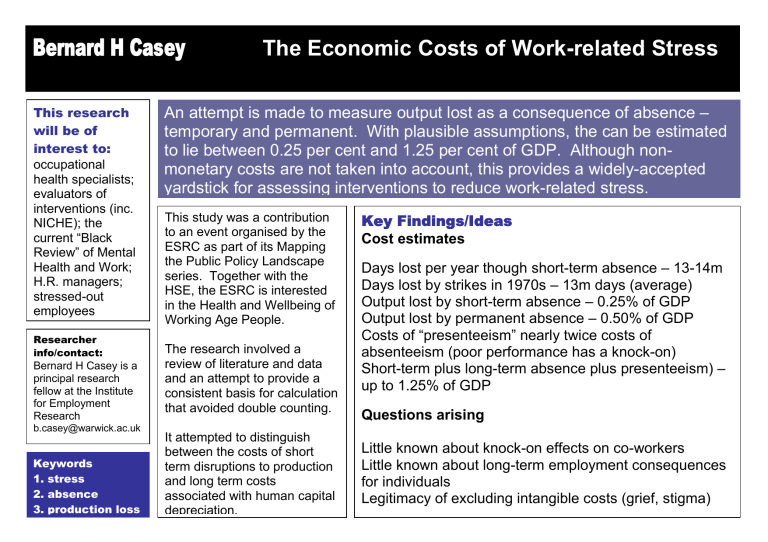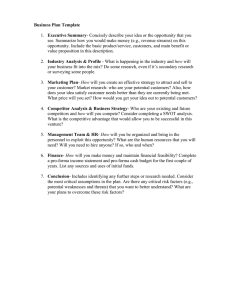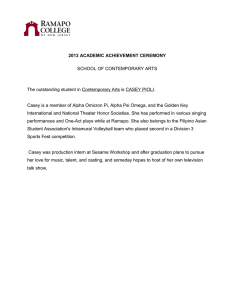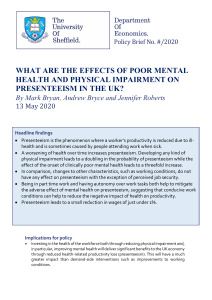Bernard H Casey The Economic Costs of Work-related Stress

Bernard H Casey
The Economic Costs of Work-related Stress
This research will be of interest to: occupational health specialists; evaluators of interventions (inc.
NICHE); the current “Black
Review” of Mental
Health and Work;
H.R. managers; stressed-out employees
Researcher info/contact:
Bernard H Casey is a principal research fellow at the Institute for Employment
Research b.casey@warwick.ac.uk
Keywords
1. stress
2. absence
3. production loss
An attempt is made to measure output lost as a consequence of absence – temporary and permanent. With plausible assumptions, the can be estimated to lie between 0.25 per cent and 1.25 per cent of GDP. Although nonmonetary costs are not taken into account, this provides a widely-accepted yardstick for assessing interventions to reduce work-related stress.
Key Findings/Ideas
Cost estimates
This study was a contribution to an event organised by the
ESRC as part of its Mapping the Public Policy Landscape series. Together with the
HSE, the ESRC is interested in the Health and Wellbeing of
Working Age People.
The research involved a review of literature and data and an attempt to provide a consistent basis for calculation that avoided double counting.
Days lost per year though short-term absence – 13-14m
Days lost by strikes in 1970s – 13m days (average)
Output lost by short-term absence – 0.25% of GDP
Output lost by permanent absence – 0.50% of GDP
Costs of “presenteeism” nearly twice costs of absenteeism (poor performance has a knock-on)
Short-term plus long-term absence plus presenteeism) – up to 1.25% of GDP
Questions arising
It attempted to distinguish between the costs of short term disruptions to production and long term costs associated with human capital depreciation.
Little known about knock-on effects on co-workers
Little known about long-term employment consequences for individuals
Legitimacy of excluding intangible costs (grief, stigma)
How to use the pro-forma (above) to make a poster:
1. Type the details of your research/name/etc over the text in the above pro-forma. i.e. type your name over ‘Researcher’s Name’; and add three sentences about your research in the grey box (deleting the ‘Overview of research in 3 sentences’ text)…. Etc.
2. If text does not fit, either: a. Cut the text b. Adjust the font size (but do NOT make it any smaller than 12 point or it will not be easy to read from a distance, even after doubling the size of the paper).
c. Adjust the size of the text boxes (you can do this by using the pointer tool on the ‘drawing’ menu).
* note: if you’re proficient at using word drawing tools, feel free to make as many changes as you want to the pro-forma
(it’s just meant as a guide)!
3. If any sections are irrelevant for your project change them.
4. Add any pictures/graphs/images you want to include.
5. When you’re done, print out the finished poster (just p.1 of this document).
6.
And copy it onto A1 paper .








